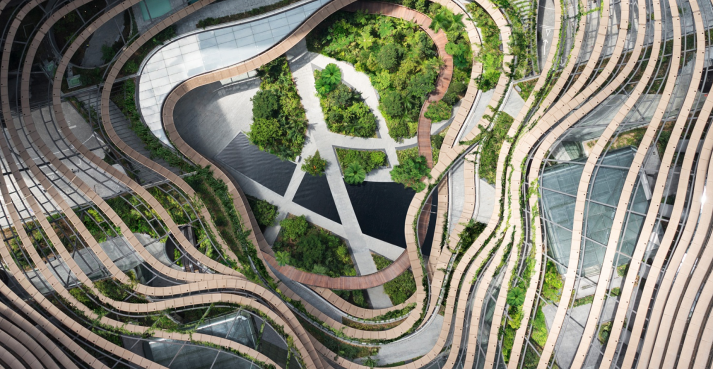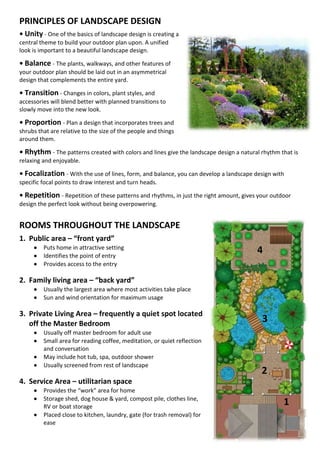A Biased View of Landscape Design
Table of Contents4 Simple Techniques For Landscape DesignEverything about Landscape DesignA Biased View of Landscape DesignThe Of Landscape DesignLandscape Design Fundamentals Explained
Formal style theme. Debt: Gail Hansen, UF/IFAS The lawn is an expansion of the home where a selection of activities happen. A yard can usually be divided into three areas: public (the front yard), personal (the garden), and solution (normally the side yard). The place of task locations depends largely on the kind of area, the size of space needed, the kind of activity, and the wanted proximity to various other tasks and frameworks.The outside wall surface of the house usually functions as the initial wall or beginning point of an outside area. Incompatible usages need to be divided, and relevant tasks, such as food preparation and dining, should be put with each other to make the yard a lot more reliable and satisfying. When making use of hardscape to produce spaces, make use of building and construction material similar to that used in your home for connection from the residence right into the yard.
Linked areas. Credit Score: Gail Hansen, UF/IFAS Making use of similar hardscape attributes and duplicating plants pulls the eye around the yard. Vital factors along the method can be emphasized with plantings or attributes that draw attention and urge movement in a specific instructions. Moving along the course takes an individual from one area to the next and allows the individual to have a range of experiences.
Fascination About Landscape Design

For mental comfort plants are utilized as physical or implied barriers for privacy and security. Physical barriers obstruct both the view and access to a room and consist of fences, walls and plant hedges.
Physical and indicated obstacles. Credit: Gail Hansen, UF/IFAS For these factors, the types of plants to be used (such as trees, shrubs, or groundcovers) must be selected in the onset of preparation (Landscape Design). Plant types are chosen for their functional abilities so that their future purpose and required room can be thought about at the same time

A Biased View of Landscape Design
Each plant mass is in front of, behind, or following to, an additional mass. Credit Rating: Gail Hansen, UF/IFAS Duplicating plants within a mass and duplicating masses with similar plants ties the yard together. The private plant features must be considered to successfully layer and mass plants.
All plant make-ups begin with the major structure plants, the big, mainly evergreen background plants-such as the trees and large bushes. These plants separate or enframe areas, manage the dimension of the space, and provide the starting point for choosing the ideal characteristics of the 2nd layer, midground plants, for massing and infill.
Important points in the yard must be highlighted by the use one-of-a-kind plants, distinctive frameworks, or garden ornaments. Marking thresholds or entryways to official source rooms can be performed with gateways, arbors, and actions, or with making use of one-of-a-kind and vibrant plants. The form and/or style motif of the garden will certainly typically help determine the essential points and how they need to be highlighted.
Various other crucial areas in the backyard are centerpieces, which is used to aesthetically organize a designed location. The type of focal point frequently depends upon the checking out viewpoint. Different perspectives or point of views can disclose different compositions in the landscape that might need a variety of focal points. Contrasting appearance, shape, dimension and color will certainly catch and hold the eye.
The 4-Minute Rule for Landscape Design

Plant forms. Credit History: Gail Hansen, UF/IFAS After kind, texture is the following leading feature of a plant; coarse, medium and fine structures can be utilized for comparison and focus in the landscape.
The enjoyable fragrance of plants, the noise of wind in the trees, the sound and texture of water, and the shades and textures of sculptures, pots and yard furniture all contribute to the experience of the garden. One information that is commonly ignored is the click to read effect of light on the aesthetic appeals of the plants.

The Ultimate Guide To Landscape Design
It is necessary to understand the ultimate mature from this source dimension of plants so they can be positioned in the right place and spaced correctly when they are mounted. Offering plants room to expand is a difficulty due to the fact that the usual mature dimension is usually based on ideal growing conditions and the ecological conditions of a website may trigger a plant to enlarge or remain smaller sized.
Comments on “Fascination About Landscape Design”